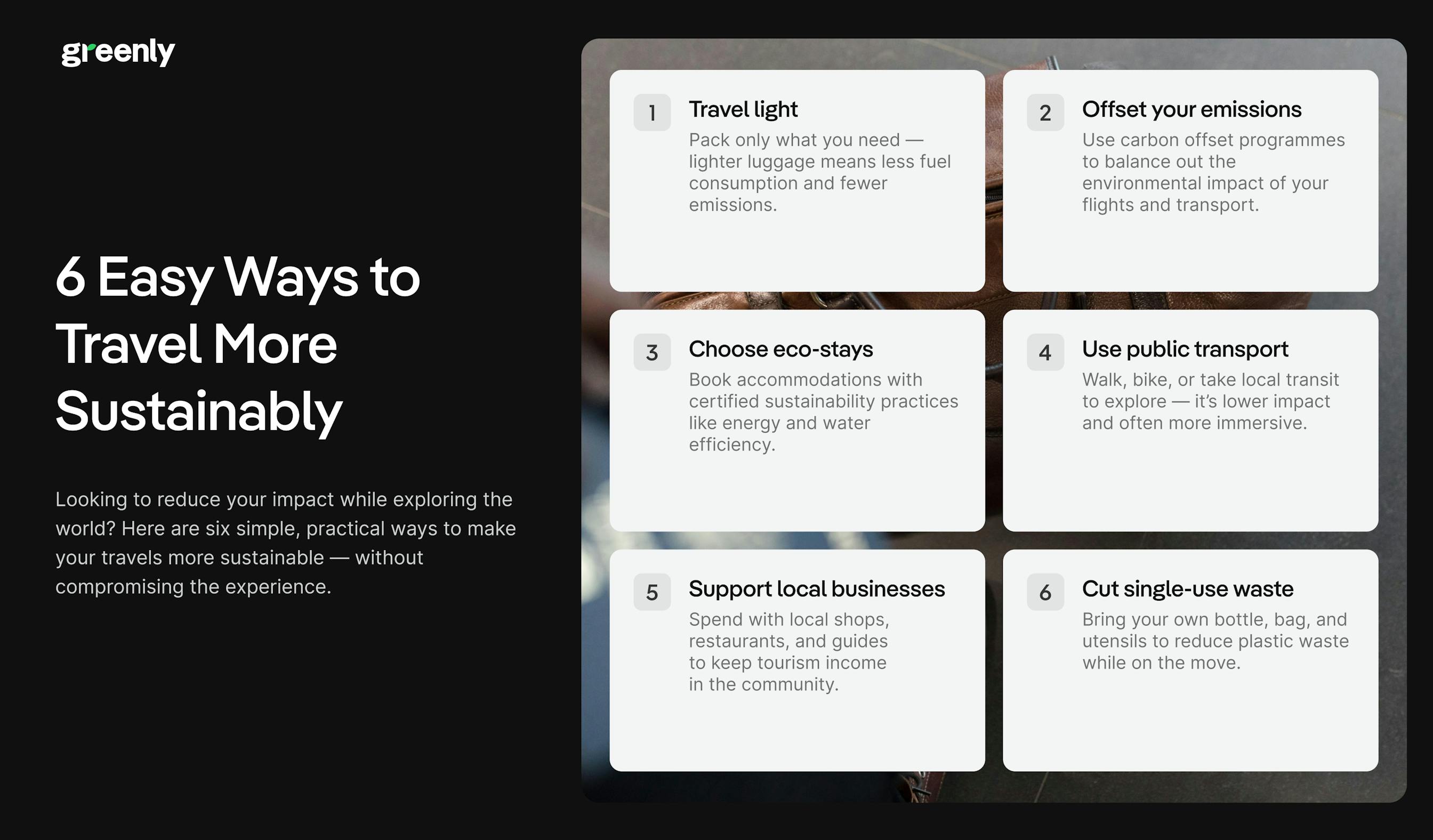ESG / CSR
Industries
Tourism & the Environment: A Delicate Balance



But while tourism brings undeniable benefits, it also places growing pressure on the environment. From carbon emissions linked to travel to the strain placed on natural ecosystems, the environmental footprint of tourism is hard to ignore.
In this article, we explore the complex relationship between tourism, the environment, and climate change, and what a more sustainable future for travel could look like.
Tourism, the environment, and climate change: a topline overview
As the number of travellers continues to rise, so too does tourism’s impact on the environment. While the industry can play a positive role in conservation and sustainable development, it also contributes to pollution, habitat degradation, and rising emissions, posing serious challenges that require urgent attention.
Tourism can drive conservation
When tourism is managed responsibly, it can do more than just minimise harm, it can actively protect the places people travel to see.
By generating revenue and building awareness, tourism can help fund conservation efforts, support local communities, and create powerful incentives to preserve nature and culture. It’s often the economic value of a destination’s natural beauty or biodiversity that justifies its protection.
Take the Great Barrier Reef, for instance. Tourism contributes over AUD $6 billion annually to the Australian economy and supports around 64,000 jobs - a strong economic case for preserving the reef. Visitor fees collected through reef tours are reinvested into initiatives like coral restoration, reef health monitoring, and crown-of-thorns starfish control - a key threat to coral cover.
Beyond Australia, countries and regions like Costa Rica, Tibet, and Bhutan have built entire tourism models around conservation. In Costa Rica, protected areas cover over 25% of the country’s land, many funded through eco-tourism. Bhutan, meanwhile, limits visitor numbers and charges a daily fee that contributes directly to environmental protection and cultural preservation.
When done right, tourism can offer a path where economic growth and environmental stewardship go hand in hand, not at odds.
But mass tourism strains ecosystems
Tourism can bring life to a destination, but too much of it can wear a place down. In cities and natural sites around the world, the pressure of mass tourism is pushing environments, infrastructure, and residents to the brink.
In Venice, the narrow canals and ancient streets now host more tourists than locals. To cope with this, the city introduced a daily entry fee in 2025, charging €5 to €10 depending on how far in advance visitors book. Tour group sizes are capped, and the message is clear: come, but tread lightly.
Other destinations are taking similar steps. Rome is weighing charges for access to iconic sites like the Trevi Fountain. New Zealand has raised visitor levies to help protect the natural landscapes that tourists travel so far to see.
The takeaway? Tourism needs boundaries. Without limits, the very things people travel to experience risk being lost.
Tourism emissions are rising rapidly
Another big issue with tourism is that it's one of the fastest-growing sources of greenhouse gas emissions. According to a 2024 study led by the University of Queensland and published in Nature Communications, emissions from tourism grew by 3.5% per year between 2009 and 2019 – more than twice the rate of global emissions overall. By 2019, the sector accounted for 8.8% of total global emissions, with aviation alone responsible for about half that total.
Lead researcher Dr. Ya-Yen Sun warned:
The study also found that 20 countries are responsible for 75% of tourism-related emissions, with the U.S., China, and India driving most of the growth, reflecting the sheer scale of inbound and outbound tourism in these regions.
Climate change threatens the future of tourism
Tourism isn’t just a contributor to climate change, it’s also one of its many victims. The very destinations that draw travellers from around the world are increasingly at risk from rising seas, extreme weather, and ecosystem collapse.
Island nations like the Maldives, Tuvalu, and the Seychelles face the existential threat of being submerged due to sea level rise. In Australia, the Great Barrier Reef has experienced repeated bleaching events driven by warming oceans, placing one of the world’s most iconic natural wonders in peril. Meanwhile, ski resorts from the Alps to the Rockies are grappling with shorter seasons and unreliable snowfall, threatening the viability of winter tourism altogether.
This growing list of climate-impacted destinations paints a stark picture: tourism cannot thrive on a planet in crisis. Without meaningful efforts to reduce emissions and build resilience, the industry risks undermining its own future.
How does tourism harm the environment?
Tourism doesn’t just leave footprints, it often leaves scars. As we've already touched on, while travel can support local economies and conservation, unchecked tourism can degrade the very environments people come to experience. Let's explore this in more detail:
One of the most significant negative impacts of tourism is the degradation of natural environments. Tourist hotspots, particularly those in ecologically sensitive areas, frequently undergo habitat destruction due to infrastructure development. The construction of hotels, resorts, roads, and other tourism facilities can result in deforestation, alteration of land, depletion of natural resources, and disruption to local ecosystems. In places like Bali, once-idyllic beaches are now flanked by sprawling resorts, affecting marine life and leading to significant erosion of the shoreline.
Waste management poses another challenge. In many popular destinations, the influx of tourists surpasses the local waste management capacity, leading to pollution. For example, Mount Everest, often referred to as the "world's highest garbage dump," is littered with oxygen cylinders, plastic waste, and even camping equipment discarded by climbers. Such uncontrolled waste not only spoils the landscape but can also contaminate local water sources, impacting both human and wildlife populations.
Water scarcity is an often-overlooked repercussion of tourism. Many tourist-heavy regions face immense pressure on their freshwater resources, either due to overconsumption by hotels and resorts or by diverting them for recreational activities. Golf courses, particularly in arid regions, consume vast amounts of water, putting local communities at risk. Islands like Santorini in Greece have seen their freshwater reserves deplete significantly, forcing them to import water or rely on desalination.
Noise and light pollution are additional concerns in areas with heavy tourist traffic. The constant hum of boats, vehicles, and human activity can disturb wildlife (including vulnerable and endangered species), affecting their natural behaviours and breeding patterns. Sea turtles, for example, which rely on the moonlight to find their way from the beach to the ocean, can be disoriented by the bright lights from beachfront properties, making their survival even more challenging.
The introduction of non-native species, whether unintentionally through transported goods or deliberately for tourist attractions, can upset the ecological balance of an area. In the Galápagos Islands, introduced species like goats and rats have wreaked havoc on the local flora and fauna, prompting extensive (and expensive) eradication programs.
How does tourism contribute to climate change?
Another major concern is how tourism substantially contributes to climate change:
Can tourism be a force for good?
Tourism is often criticised for its environmental footprint, but in many parts of the world, it’s also a lifeline. When managed responsibly, it can bring more than just income. It can fund conservation, empower communities, and turn natural and cultural heritage into assets worth protecting.
A reason to protect, not exploit
In countries with limited industrial capacity, tourism offers a powerful economic alternative to environmentally damaging industries like mining or logging. Nature becomes more valuable intact than destroyed.
Take Kenya, for example. The country’s national parks -home to lions, elephants, rhinos, and more - are now central to its economy. Entrance fees, safari tours, and lodge stays generate revenue that supports not just wildlife conservation but local livelihoods. The visibility of these animals to tourists has, in some cases, made them safer from poaching - alive, they bring in more value than they ever could as trophies or trade.
Community benefits and local jobs
Tourism also creates jobs in remote or rural areas where other opportunities may be scarce, from guiding and hospitality to transport and crafts. Crucially, these jobs often depend on healthy ecosystems and cultural integrity, incentivising their preservation. Community-based tourism models, where locals are directly involved and benefit from tourism operations, are proving particularly effective in places like Nepal, Namibia, and parts of Latin America.
A tool for awareness
Beyond the dollars, tourism can spark environmental awareness. A trip to the Arctic, the Amazon, or a coral reef can leave travellers with a first-hand understanding of what’s at stake, and sometimes, a desire to act. Donations, advocacy, and policy shifts often follow personal experience.
The paradox of climate-vulnerable destinations
Some of the most climate-vulnerable places on Earth are also those most dependent on tourism. Small island nations, coastal towns, and remote landscapes often have few alternatives to tourism as a source of income, and yet, they’re the first to feel the consequences of a warming planet.
The Maldives, Fiji, the Seychelles, the Caribbean - these destinations rely heavily on air travel to survive economically, yet they sit on the front lines of rising seas and stronger storms. The irony is stark: the very activity that sustains them also threatens their future.
This isn’t just an environmental issue, it’s a question of justice and survival. How can these nations keep their economies afloat without accelerating the climate crisis that puts their existence at risk?
There’s no easy answer, but solutions are emerging:
- Investing in more resilient infrastructure, from elevated buildings to renewable-powered resorts.
- Diversifying economies so tourism isn’t the only lifeline.
- And rethinking what high-value, low-impact travel could look like - i.e. fewer visitors, staying longer, spending more, and doing less harm.
Addressing this paradox means designing a tourism model that gives these destinations a future.
The future of tourism
The future of tourism is marked by both challenges and opportunities. As global travel continues to grow, the need to address its environmental impact becomes increasingly urgent. Industry leaders must transition towards sustainability, preserving the planet while still allowing people to explore its wonders.
Eco-tourism, a growing segment within the travel industry, emphasises responsible travel to natural areas that conserve the environment, sustain the well-being of local people, and involve understanding and education. This form of tourism encourages minimal impact on the environment while providing economic benefits to local communities. For example, destinations like Costa Rica have successfully marketed themselves as eco-friendly hotspots, where tourists can enjoy the natural beauty while contributing to conservation efforts.
When it comes to tourism development, investing in renewable energy and green infrastructure is crucial for making tourism more sustainable. Tourism businesses — from boutique eco lodges to large hotel chains — are beginning to adopt solar and wind power, reduce water usage, and implement waste reduction strategies. Moreover, the rise of green building certifications, such as LEED, in the hospitality industry reflects a growing commitment to sustainability. Cities like Copenhagen, for example, have pioneered green urban tourism, integrating bike-sharing programs, extensive green spaces, and energy-efficient public transportation.
While the reduction of air travel emissions remains a significant challenge, carbon offsetting programs offer a way for travelers to mitigate their impact. Airlines and travel agencies are increasingly offering carbon offset options, allowing customers to invest in environmental projects that reduce greenhouse gases. Additionally, the promotion of eco-friendly transportation alternatives — such as electric vehicles, high-speed trains, and cycling — is gaining momentum as a way to reduce the environmental footprint of tourism travel. In Europe, there has been a marked shift towards train travel for short to medium distances, reducing reliance on flights.
Community-based tourism (CBT) focuses on empowering local communities by involving them directly in the tourism industry. This model ensures that the economic benefits of tourism are distributed fairly and that both cultural diversity and environmental integrity are maintained. By fostering a deeper connection between tourists and local cultures, CBT enhances the travel experience while promoting conservation and sustainable development. In places like Bhutan, where tourism is heavily regulated, visitors pay a sustainable development fee that contributes to the country's conservation and cultural preservation efforts.
How can you reduce your environmental impact when traveling?
As awareness of the environmental impact of travel grows, individuals are increasingly looking for ways to minimise their carbon footprint while still enjoying the benefits of exploring new places. Sustainable travel is not just about making better choices on the road; it's about planning ahead and being mindful of the consequences of your actions. By adopting eco-friendly practices, travelers can contribute to the preservation of the environment and help mitigate the negative effects of tourism.
Below are some actionable steps individuals can take to reduce their environmental impact while traveling.
| Action | Description |
|---|---|
| Choose Eco-Friendly Accommodations | Opt for hotels and accommodations with strong environmental practices, such as energy efficiency, waste reduction, and water conservation. Look for certifications like LEED or Green Key. |
| Travel Light | Pack only what you need. Lighter luggage means less fuel consumption during transportation, which helps reduce carbon emissions. |
| Offset Your Carbon Emissions | Use carbon offset programmes to compensate for the emissions generated by your flights or other modes of transportation. Invest in projects that reduce or remove carbon from the atmosphere. |
| Use Public Transport | Whenever possible, use public transport, walk, or cycle instead of renting a car or taking taxis. This reduces your carbon footprint and is often a more immersive way to experience a destination. |
| Support Local Businesses | Spend your money at locally-owned businesses, such as restaurants, shops, and tour operators. This helps to support the local economy and reduce the environmental impact of transporting goods over long distances. |
| Reduce Waste | Carry a reusable water bottle, shopping bag, and utensils to minimise single-use plastic waste. Avoid products with excessive packaging. |
| Respect Local Wildlife | Avoid activities that exploit animals, such as riding elephants or visiting poorly managed zoos. Support ethical wildlife tours and sanctuaries that prioritise animal welfare. |
| Be Energy Conscious | Turn off lights, air conditioning, and electronics when not in use. Consider taking shorter showers and reusing towels to conserve water and energy. |
| Avoid Over-Tourism Hotspots | Explore less popular destinations to avoid contributing to over-tourism. This helps reduce the environmental strain on popular sites and offers a more unique travel experience. |
| Educate Yourself and Others | Learn about the environmental impact of your travel choices and share this knowledge with others. By raising awareness, you can help spread the importance of sustainable travel. |


A call to action
The future of tourism depends on the collective efforts of all stakeholders - governments, businesses, communities, tourism professionals, and travelers.
Tourism companies must commit to sustainability, not merely as a marketing activity, but as a core part of how they operate and grow. Policymakers must implement regulations that incentivise sustainable practices, such as carbon taxes on flights and stricter environmental standards for tourism operators, helping align the industry with the UN Sustainable Development Goals.
Local communities should be empowered to manage tourism in ways that benefit them economically while preserving their cultural and natural heritage. Travelers, too, must embrace a mindset of responsibility, understanding that every journey has an impact and making choices that minimise harm to the environment.
How Greenly can help your company
As a company committed to sustainability, we believe that businesses have a crucial role to play in transforming industries to ensure they are both environmentally responsible and economically viable for future generations. Greenly can help businesses lead the way by providing comprehensive carbon management solutions that simplify the journey to net zero:
Carbon Management with Greenly
- Measurement of GHG Emissions: Track Scope 1, 2, and 3 emissions using advanced tools and technology for a full picture of your company's greenhouse gas footprint.
- Custom Action Plans: Work with Greenly's climate experts to develop tailored strategies focused on key areas for improvement.
- Decarbonising Your Supply Chain: Supply chain emissions (Scope 3) are often the most challenging to manage, but they're crucial in achieving net-zero goals. Greenly helps companies transition to low-carbon options and build more sustainable partnerships.
- Intuitive Platform: Our user-friendly platform provides a seamless experience for managing your company's environmental impact, tracking progress against ESG goals, and integrating sustainability into every aspect of your business operations.
Why Choose Greenly?
Greenly provides comprehensive support throughout your sustainability journey, from carbon measurement and custom action plans to supply chain decarbonisation and platform integration. By partnering with Greenly, your business can significantly reduce its environmental impact and lead the way in sustainability.
Start your journey toward net zero with Greenly today and build a more sustainable future for your company.












